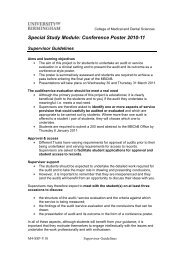Contents - College of Medical and Dental Sciences - University of ...
Contents - College of Medical and Dental Sciences - University of ...
Contents - College of Medical and Dental Sciences - University of ...
You also want an ePaper? Increase the reach of your titles
YUMPU automatically turns print PDFs into web optimized ePapers that Google loves.
The 11 th International Workshop on KSHV & Related Agents, Birmingham, UK<br />
Virus-Cell Interactions I Abstract 27<br />
KSHV AND CELLULAR MIRNA EXPRESSION DURING LATENCY AND LYTIC<br />
REACTIVATION IN PEL CELLS<br />
*1Soo-Jin Han * 1 Jianhong Hu, * 1 Karlie Plaisance * 2 Wendell Miley 2 Rachel Bagni, Chang<br />
Hee Kim 3 , 2 Denise Whitby <strong>and</strong> 2 Rolf Renne<br />
1. Department <strong>of</strong> Molecular Genetics <strong>and</strong> Microbiology, <strong>University</strong> <strong>of</strong> Florida, Gainesville,<br />
Florida 32610, 2.Viral Oncology Section, AIDS <strong>and</strong> Cancer Virus Program, SAIC-<br />
Frederick, NCI-Frederick, Frederick MD 21702 3. Laboratory <strong>of</strong> Molecular Technology,<br />
Advanced Technology Program, SAIC-Frederick, NCI-Frederick, Frederick, MD 21702<br />
(*equal contribution).<br />
Abstract<br />
MicroRNAs are small non-coding RNA molecules which post-transcriptionally regulate<br />
gene expression by binding to 3’UTRs <strong>of</strong> target genes thereby contributing to important<br />
biological processes. Kaposi’s sarcoma associated herpesvirus (KSHV) encodes 12<br />
miRNAs within the KSHV latency associated region (KLAR), some <strong>of</strong> which target host<br />
cellular genes thereby affecting angiogenesis, apoptosis, <strong>and</strong> B cell development.<br />
Originally, KSHV miRNAs were cloned from BCBL-1 cells in the presence <strong>and</strong> absence <strong>of</strong><br />
TPA induction, suggesting that miRNAs may contribute to both phases <strong>of</strong> infection.<br />
The KLAR region is expressed from at least three different promoters giving rise to singly<br />
<strong>and</strong> multiply spliced transcripts. To further elucidate the complexity <strong>of</strong> this locus with<br />
emphasis on transcripts that could serve as pri-miRNAs, we performed a detailed RT-PCR<br />
<strong>and</strong> RNase protection analysis <strong>and</strong> identified several new transcripts that could give rise<br />
to miRNA expression. We identified novel multiply-spliced transcripts originating from the<br />
LANAp <strong>and</strong> LTI promoters upstream <strong>of</strong> LANA, which contained 3’ exons within the<br />
Kaposin locus. Furthermore, the observed splicing patterns from these long KLAR<br />
encompassing transcripts changed during lytic replication, suggesting that both LANAp<br />
<strong>and</strong> LTI could drive miRNA expression.<br />
Next, we utilized a custom miRNA array containing both viral <strong>and</strong> human miRNAs to<br />
investigate miRNA output in PEL cells during latency <strong>and</strong> reactivated by Ad-ORF50.<br />
Surprisingly, while we identified marked changes in the splicing pattern in this region,<br />
viral miRNA expression was not significantly altered in PEL cells 48 hours post<br />
reactivation. Cellular miRNA expression signatures during both conditions will also be<br />
discussed.<br />
Presenting author Email: rrenne@ufscc.ufl.edu<br />
50















